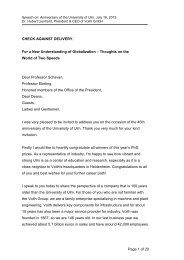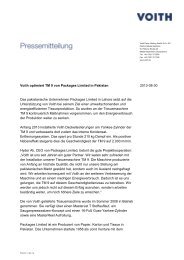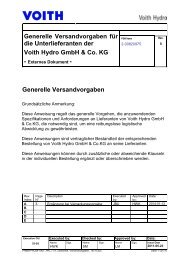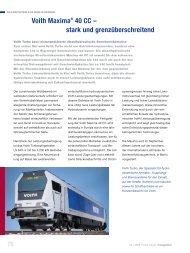2 Water for life requires inventiveness I Daio Paper Mishima ... - Voith
2 Water for life requires inventiveness I Daio Paper Mishima ... - Voith
2 Water for life requires inventiveness I Daio Paper Mishima ... - Voith
You also want an ePaper? Increase the reach of your titles
YUMPU automatically turns print PDFs into web optimized ePapers that Google loves.
Wood fibers are separated and prepared. Pulp is delivered to the paper mills as pressed sheets.<br />
Clothing <strong>for</strong> pulp drying machines are in a different class<br />
Definitely heavyweight!<br />
<strong>Voith</strong> <strong>Paper</strong> Fabrics offers a complete product plat<strong>for</strong>m <strong>for</strong> all types of pulp drying applications from<br />
conventional <strong>for</strong>ming and press sections to the most modern machines available in the market.<br />
Did you know that more than<br />
one-third of the world’s market pulp<br />
production is made on clothing from<br />
<strong>Voith</strong> <strong>Paper</strong> Fabrics?<br />
Let’s start from the beginning with<br />
some facts about market pulp.<br />
What is market pulp and how is it<br />
gained?<br />
Pulp is wood fibers that are separated<br />
and made suitable <strong>for</strong> paper and<br />
board production. The pulping process<br />
separates individual fibers by<br />
mechanical, chemical or semi-chemical<br />
methods. Most of market pulp is<br />
chemical pulp. Pulp is mainly produced<br />
from wood but alternative materials<br />
are continually being sought, e.g.<br />
26 I 2008 I <strong>Voith</strong> <strong>Paper</strong> I twogether<br />
hemp, kenaf and bamboo fibers.<br />
The resulting substance, called pulp,<br />
is <strong>for</strong>med into thick sheets and transported<br />
from the pulp mill to a paper<br />
mill.<br />
Side products such as chemicals and<br />
water are recycled. The “black liquor”<br />
is used <strong>for</strong> energy generation.<br />
Optimization has reached a stage<br />
where the excess energy produced is<br />
sold to the regular market. Some<br />
chemicals are recovered <strong>for</strong> re-use in<br />
the pulping process and also <strong>for</strong> the<br />
cosmetic industry.<br />
Market pulp production<br />
It’s important to separate market pulp<br />
from the global pulp production.<br />
PRoDUCTs<br />
Market pulp is dried on a pulp drying<br />
machine and sold as raw material to<br />
the paper and board industry. The<br />
global pulp production on the other<br />
hand includes all pulp production,<br />
integrated mills and market pulp.<br />
The pulp industry is still dominated<br />
by North American mills, but the<br />
strongest growth rates can now be<br />
found in Latin America and Asia with<br />
their warm climates that favor fast<br />
plant growth. Worldwide production<br />
volume reached 54 million tons in<br />
2006, and market analysts expect<br />
continued growth of about nine million<br />
tons per year <strong>for</strong> the <strong>for</strong>eseeable<br />
future. All market pulp is not created<br />
equally; different raw materials and<br />
45

















